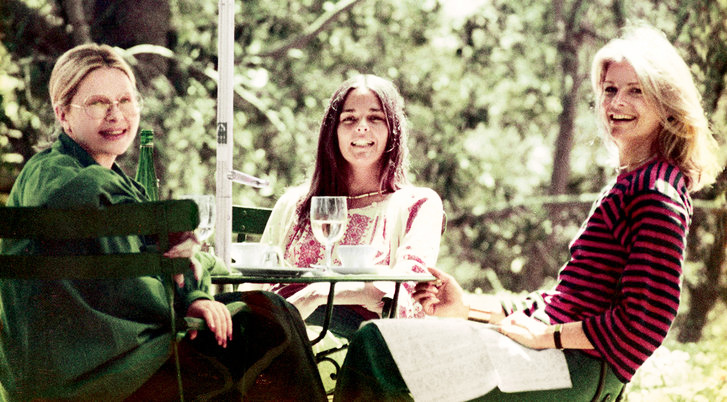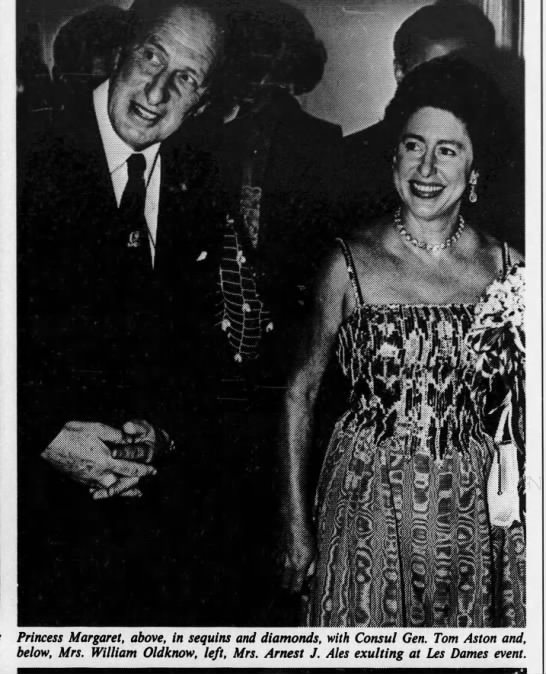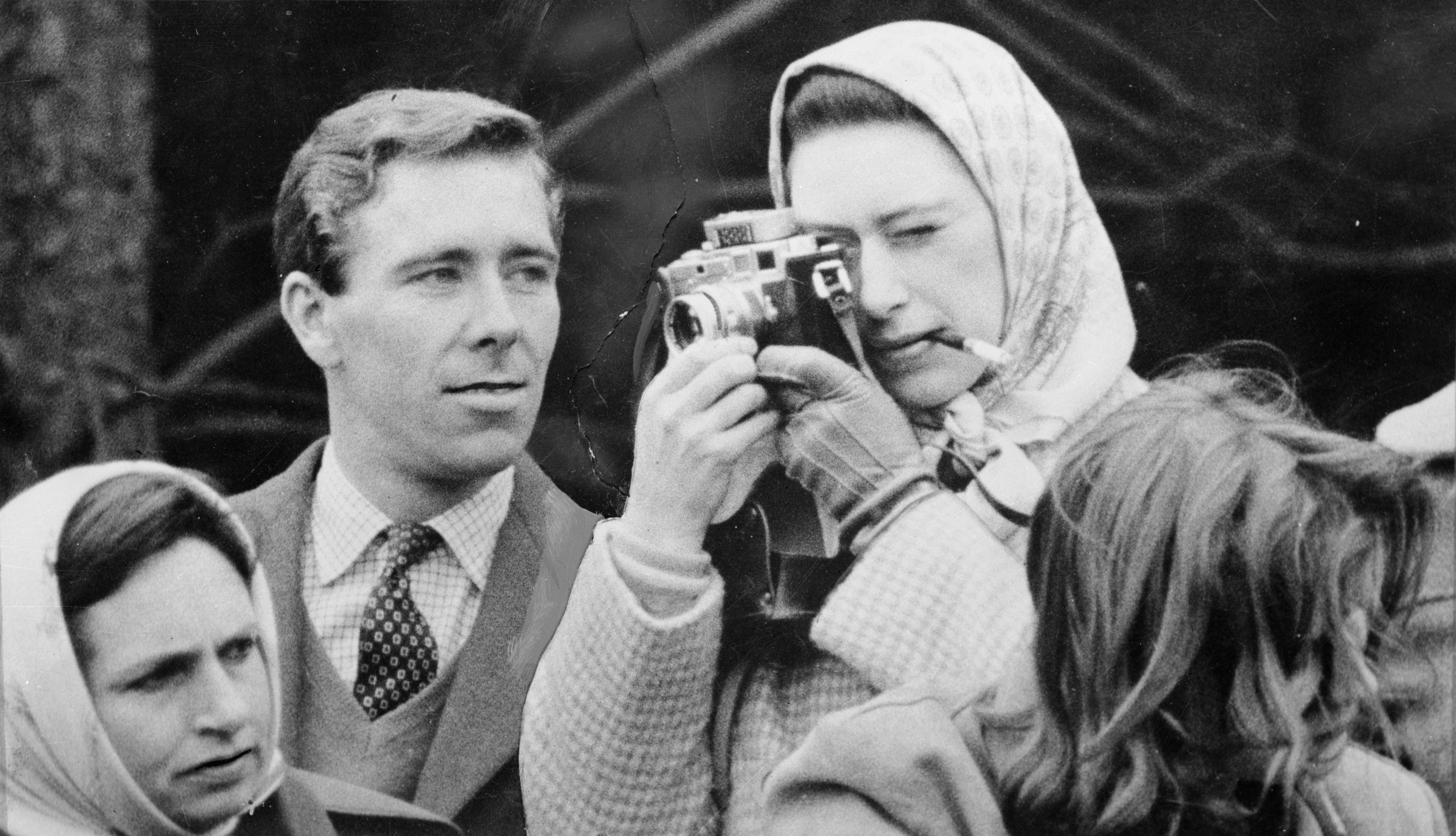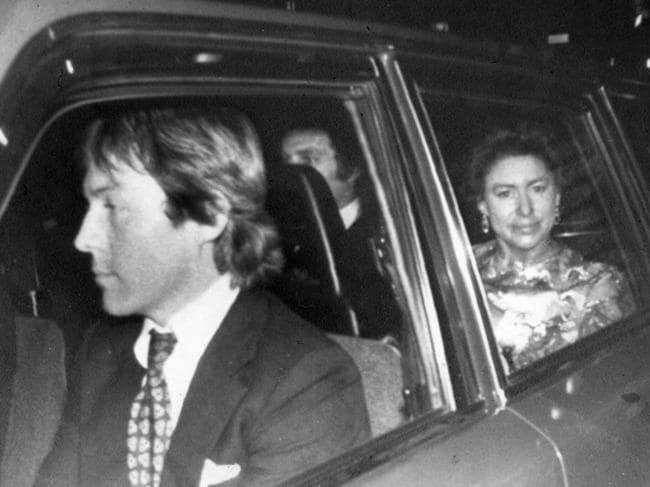Readers, be sure to read my preceding posts on Princess Margaret’s October 1979 Trip to America. Part One. Part Two. Part Three. Part Four

Hollywood celebrity powerhouse agent, Sue Mengers, and her client, Ryan O’Neal. After 1972’s hugely successful movie, “What’s Up, Doc?,” Sue became known as the most successful packager in the business: she had put director Peter Bogdanovich together with Barbra Streisand and Ryan O’Neal. In 1979 when Princess Margaret dined at her Beverly Hills home, Sue Mengers was at the peak of her power. Her phone rang incessantly with calls from actors and directors and screenwriters, all wanting to work with her.
The 1970s era Hollywood super agent Sue Mengers was only interested in representing the top talent in the industry. Her“bulging celebrity contacts book” included Barbra Streisand, Jack Nicholson, Mike Nichols, Ali McGraw, Peter Bogdanovich, Faye Dunaway, Bob Fosse, Cybill Shepard, Sidney Lumet, Cher, Michael Caine, Ryan O’Neal, Candice Bergen, Gene Hackman, Burt Reynolds, and on and on.

The first female super agent Sue Mengers, left, with clients Ali MacGraw and Candice Bergen. Early 1970s.
For a time, there was only thing more star-studded than Sue Mengers’ client list: one of her parties at her mansion atop Bel Air. It was said that
“If a bomb went off on Bel Air Road, then half of Hollywood would be obliterated.”
Sue’s dinners were as exclusive as they were intimate. At one of Sue’s legendary parties at her grand home, Johnny Carson, the host of NBC’s “The Tonight Show,” looked around at the other guests assembled and complained,
“God, there are too many stars here, not enough sycophants!”
Bawdy, brash, and pushy, Sue Mengers had met Princess Margaret in the fall of 1978 at the London home of literary critic, Kenneth Tynan, and said to her that she would love to throw her a party, should the Princess ever find herself in Los Angeles. The following March, Sue received a call from Princess Margaret’s social secretary, saying that the Princess would indeed be in L.A. in October and would like to take Sue up on her party offer.
‘It seemed like we did nothing from March to October but plan the party,’ said Sue’s assistant, Cindy Pearson. (1)
Usually, Sue set out sugar bowls filled with cocaine and rolled joints for party guests—but not on this occasion. For the formal sit-down dinner for fifty, she hired a chef and a staff of 25. She laid out her best china and silver and had to borrow some from Marcia Diamond, Neil’s wife. Although she was a seasoned and celebrated hostess, Sue, a chain smoker, was nervous as a cat. In the days leading up to the event, many of her friends and clients thought Sue was going to have a nervous breakdown. She lost weight and cut her beautiful, blond hair. Everything had to be perfect. For years, she had studied the lives of the British royal family and learned the finer points of protocol. She idolized Princess Margaret and hated her own mother whose name was Ruth. Sue always used to say,
“Sure—instead of being born to Princess Margaret, I got born to Ruth.”
Then, four days before the dinner, on Tuesday, October 16, 1979, the Los Angeles Police Department learned of a credible threat to the Princess’ life. Intelligence sent by the U.S. State Department indicated that an Irish Republican Army terrorist had been dispatched to murder Margaret during her three day stay in Los Angeles. Sue’s assistant Cindy Pearson said,
“The party was on a Saturday night and several days before, Scotland Yard people were sent with bomb dogs to smell the house.”
For some reason, a third-floor bathroom was locked after the dogs had cleared it, and no one could use it until the Princess’ arrival.

On Saturday, October 20, 1979, a few hours before the dinner at the Beverly Hills home of agent Sue Mengers, Princess Margaret made an appearance at a charity function held at Bullock’s Wiltshire Department Store, L.A. Outside she was greeted by an angry mob of 30 people yelling “Filthy Swine!” and holding up placards decrying the British presence in Northern Ireland. Members of “Action for Irish Rights” tried to present the Princess with a pig’s head on a platter. Two live pigs were there. The next day, she would travel to San Francisco where Irish-American activists promised to flood her hotel with 1,000 pigs (but only one would show up) and a crowd, some dressed as pigs or holding stuffed pigs, would chunk rocks at the limousine of her hostess, Mrs. Gordon Getty.
Security that Saturday night was intense. The dinner Sue Mengers gave in honor of Princess Margaret attracted every “twinkly” (star) in Hollywood. Everyone entering Sue’s palatial home was searched. The guest list at the informal affair included Barbra Streisand (and Jon Peters), Jack Nicholson (and Angelica Huston), Candice Bergen, Michael Caine (and Shakira), Robin Williams (and Valerie), Neil Diamond (and Marsha), Ryan O’Neal (and Farrah Fawcett, “fetching in black silk pajamas”), John Travolta, and Gregory Peck. Ali MacGraw, wearing a short black and gold dress came stag. Her boyfriend, Steve McQueen, was absent because he had snorted too much cocaine and had made himself sick. This made Sue furious. Hunks Nick Nolte (1992 People magazine’s “Sexiest Man Alive”) and Sean Connery (1989 People magazine’s “Sexiest Man Alive” and the “Sexiest Man of the Century in 1999”) were there. Princess Margaret had met Sean Connery on her 1965 visit to California. He had given her a gold lighter engraved with “007” which she proudly showed others. Gore Vidal, David Geffen, Barry Manilow, Joni Mitchell, and music agent Peter Asher also attended Sue’s bash.
Jerry Brown, governor of California and presidential hopeful, arrived with his longtime love, rocker, Linda Ronstadt, 33. Linda looked stunning, dressed way down, wearing a simple white cotton mini-dress and some little red boots. At that year’s American Music Awards Linda won two awards: Best female pop/rock vocalist and female country single “Blue Bayou.” She sang everything: rock, country, mariachi, rhythm and blues, big band tunes. Although the room was full of gorgeous women, men always turned to look at Linda. As singer Willie Nelson remarked,
“There are two kinds of men in this world. Those with a crush on Linda Ronstadt and those who never heard of her.”
Fans said of her:
“She took your breath away.”
“Linda was electric in performance.”
In the 1970s, Linda Ronstadt was everybody’s sweetheart. She was a class act in concert, barefoot, wearing off the shoulder Mexican blouses, jeans, with a flower tucked behind one ear. She was sexy without twerking and her voice was clear and strong and could make sad songs feel even sadder.
Linda Ronstadt and Jerry Brown had been going together since the early 1970s and were the source of much gossip. They were considered wildly different. People speculated on what she might be like as a First Lady should he be elected to the U.S. Presidency following Jimmy Carter.

The comic strip, “Doonesbury” by American cartoonist Garry Trudeau, chronicled the hard-to-pin down relationship between Linda Ronstadt and Governor Jerry Brown of California in the 1970s. These were freewheeling times and the country was paying attention to a couple that might occupy the White House.
Linda and Mick Jagger were great friends. At that time, Mick would stay at Linda’s Hancock Park home in L.A. when Linda wasn’t there while he was divorcing Bianca.
Princess Margaret was also friends with Mick and Bianca. Although this could have been a conversation that would have drawn the Princess and Linda into a friendship at the dinner, that was not going to happen. Linda was competition for the Princess.
At 8:30 p.m., the Princess arrived in a police motorcade with her lady-in-waiting, Lady Annabel Whitehead. The guests were seated inside. The Princess made her entrance. The guests would not have stood up in her royal presence. Perhaps they gave her a little clap, which was allowed.
The Princess was wearing a black and silver dress by Dior. She wore jewels handed down to her from her grandmother, Queen Mary: a necklace of blazing round diamonds (at least 3 carats each) and drop diamond earrings.
Sue Mengers had adhered to Emily Post advice for seating protocol when entertaining a dignitary such as Her Royal Highness Princess Margaret, Countess of Snowdon. To the Princess’ right, she seated the person next-highest-in-rank, Governor Jerry Brown. The rest of the seating assignments were left to the hostess’ discretion. Sue decided to seat Margaret’s fellow Brit, actor Michael Caine, to her left. They fell into an instant rapport.
The same could not be said of her relationship with Governor Jerry Brown. Jerry Brown, as is true with many politicians, was never in doubt as to his prominence in a room. He started off his relationship with Princess Margaret by turning to her and saying,
“Good evening, Your Highness, I just dropped by to say hello. I have another appointment, so I’m only staying for the first course.”
Oh, my goodness. He must have not have gotten the memo. When you first speak to the Princess, you call her, ‘Your Royal Highness.” He had left out the all-important word, “royal.” If he had read his history, he would have known how all important that word was to a royal person. In 1936, King George VI, Margaret’s father, had denied Wallis Simpson the right to be called “HRH” even thought her husband, the Duke of Windsor, was allowed to remain an “HRH” following his exile to France. This slight caused such hurt that the Duke and Duchess of Windsor began to play around with Nazis, perhaps looking for a new kingdom they could rule.

The Duchess of Windsor (formerly Wallis Simpson) shakes hands with Adolf Hitler, 1937, in Munich, as her husband, the Duke of Windsor (formerly King Edward VIII of Great Britain), looks on. AP Photo.
The second faux pas committed by Jerry Brown, the visionary nicknamed “Governor Moonbeam” for his belief that solar power would one day power homes and offices, was his plan to get up and leave before the Princess left. This just was not done! Everyone could begin eating when she lifted her fork. Everyone could leave once she had left.
The Princess said not a word to Governor Brown. She turned her back on him and, turning to her left, struck up a conversation with Michael Caine who was breaking into American films after having made a name for himself in British ones.
As the dinner was informal, the dinner was a buffet style. The guests at the first table (we shall call, “Table One”) lined up in the buffet line, following the Princess. In her column, “Suzy Says,” (Daily News, Oct. 23, 1979), Suzy remarked that, along with the others at Table One, the Princess
insisted on standing in the buffet line herself and helped themselves to a dinner of sesame chicken, lasagna, ham (obviously, Sue Mengers had not been following the Irish pigs scandal), and homemade ice cream.
Once Table One had returned to their seats with their plates, Linda Ronstadt rose from her chair from across the room—she was not seated with her date—and approached Governor Brown. She had not yet been through the buffet line. Standing by Brown’s chair, she asked, looking down at his plate,
“‘What are we having to start?” She then leaned over with the intention of taking a piece of food off his plate in order to taste it. In doing so, she not only put one hand on the governor’s shoulder, but she also put the other on the Princess’ shoulder.
Michael Caine was watching.
“‘I have seen people shrug many times, but the Princess’ shoulder shrugged like a punch from a boxer and with almost the same effect on Miss Ronstadt. She [Linda] almost overbalanced and fell on the floor.'”
Never once did Her Royal Highness even look up.
When Jerry Brown left the party in the middle of the meal, the Princess still had not spoken a word to him. Once he was gone, she turned to Michael Caine and remarked, “What a dreadful man.” (2)
Sue attached herself to the Princess for most of the evening, recalled Michael Caine.
“They got on like a house on fire.”
Sue could not stop curtseying to her exalted guest. Every time the Princess looked her way, she curtseyed.
Helicopters circled above all night, making the most tremendous racket. Police searchlights filled the garden. Guest Michael Black remembered that “Princess Margaret got a little sauced and was definitely coming on to John Travolta.” Prodded by Gore Vidal, Jack Nicholson offered the Princess some drugs, saying he wanted to get to know her better, but she turned him down.

Sue Mengers and Jack NIcholson. Photo by BEI/Shutterstock
At 12:30 p.m., Princess Margaret departed with the manager of the Rolling Stones, Prince Rupert Loewenstein (full name: Rupert Louis Ferdinand Frederick Constantine Lofredo Leopold Herbert Maximilian Hubert John Henry zu Löwenstein-Wertheim-Freudenberg, Count of Loewenstein-Scharffenecka), a Bavarian aristocrat who would turn out to be a financial wizard for the Stones’ fortunes.
Everyone told Sue that the party was perfect but she was sure that Jack Nicholson had ruined everything. Now she would never be invited to Buckingham Palace.
And she never was.
This cursed fund-raising trip was said to have raised a mere half-million dollars for the Royal Opera House at Covent Garden, and much of that had been pledged before the Princess had even left Britain.
By the end of the month, the Princess had arrived on the island of Mustique to reunite with her younger lover, Roddy Llewellyn. He, too, had suffered from the fallout from the Princess’ less-than-choice remark, “The Irish, they’re pigs.” He had learned that some irate members of his community back in Fulham, England, had smashed up the terracotta pots outside his flat and emptied the plants and dirt into his basement. Roddy loved his plants. This upset him very much.
Sources:
(1) Kellow, Brian. Can I Go Now?: The Life of Sue Mengers, Hollywood’s First Superagent. 2015.
(2) Caine, Michael. What’s It All About? 1993.
Readers: For more on Princess Margaret, click here.
Readers: For more on the British royal family, click here.






























